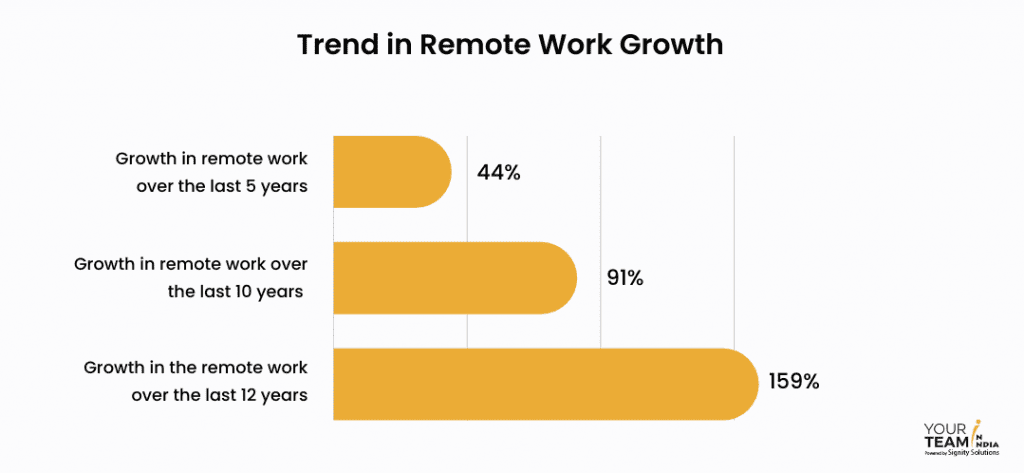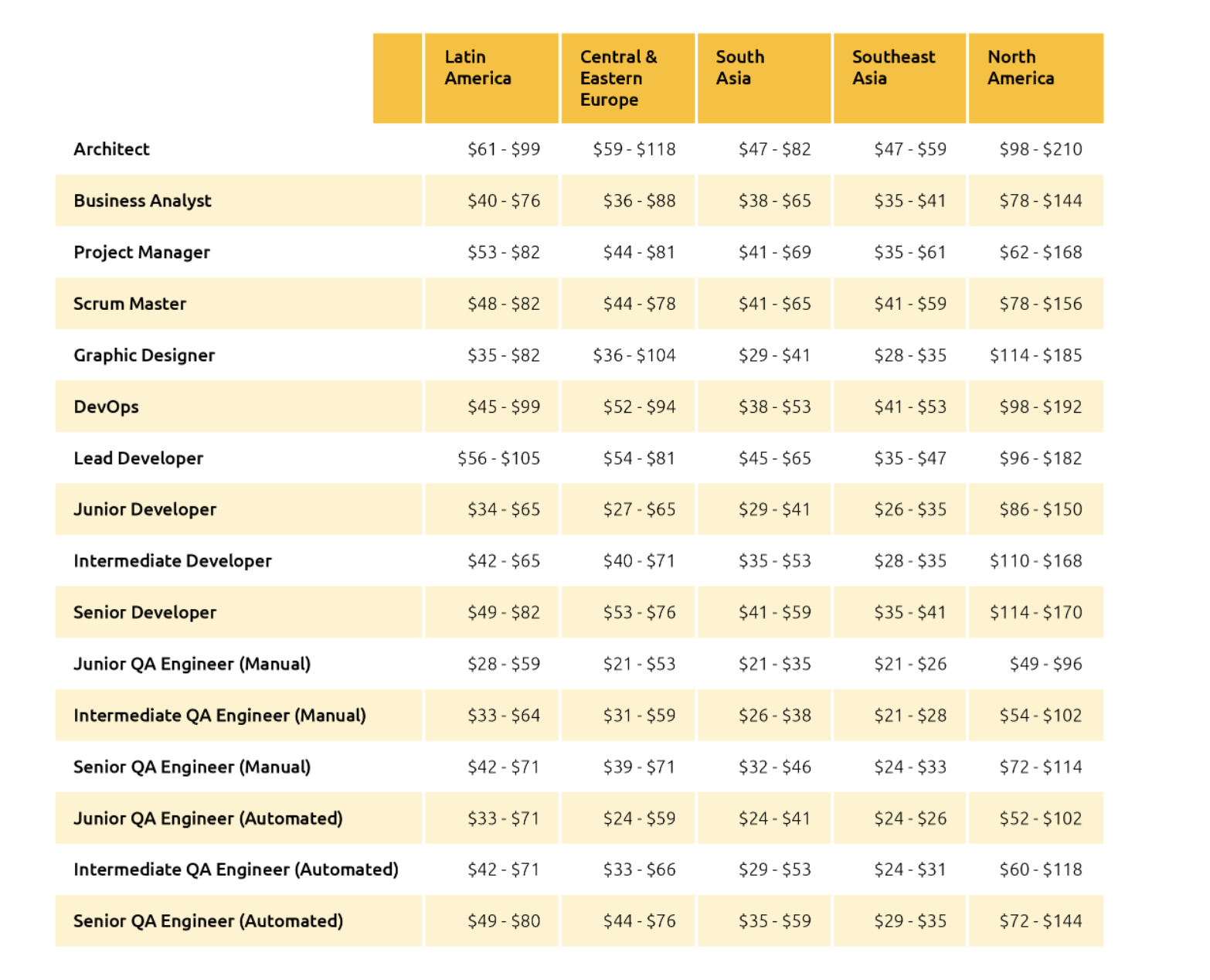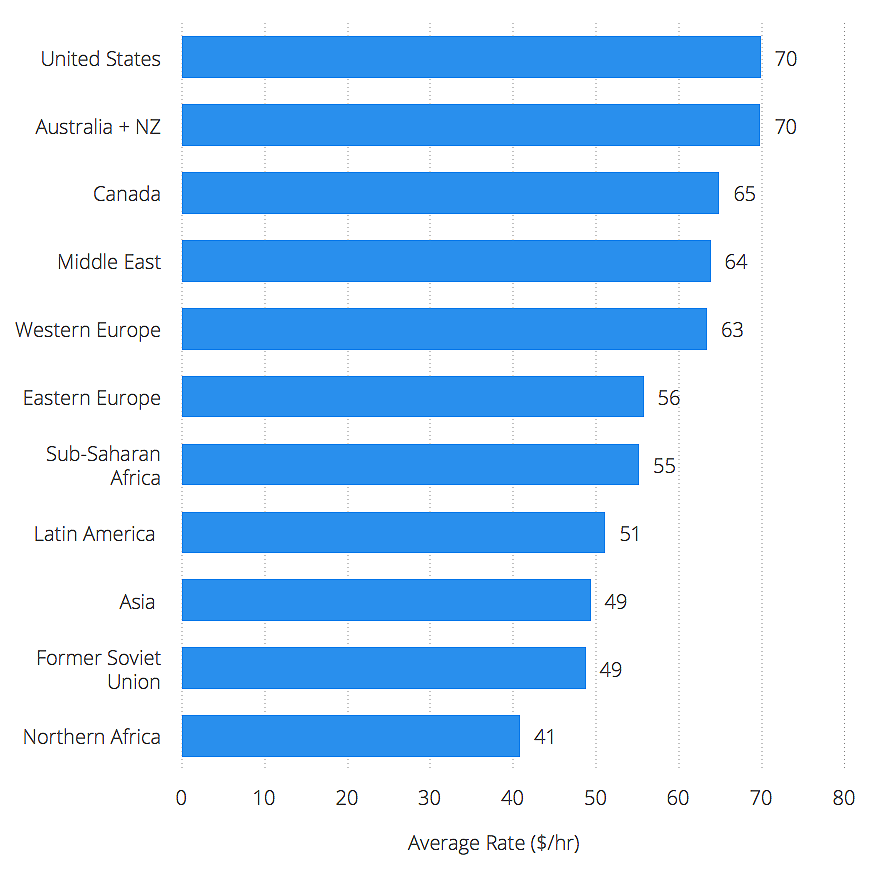Quick Summary: Building a successful remote development team is crucial in today's globalized and digital world. This article will guide project managers, business owners, and entrepreneurs on how to create and manage a thriving remote development team.
Introduction
Did you know that remote work has not only transformed how people work but also boosted productivity and improved deadline management? In a recent study, it was found that 44% of employees who can do their jobs from home believe that remote work has made it easier for them to meet deadlines. Additionally, 64% of survey respondents agree that remote work has enhanced their productivity.

These numbers reveal the immense potential of remote work in unlocking higher levels of efficiency and meeting project goals. With such compelling evidence, it's no wonder that businesses across various industries are choosing remote development team models over in-house teams.
However, managing remote development teams requires unique approaches and specialized tools. It also requires effective management strategies different from those used for in-house teams. If you want to know how to manage remote developers in your team, you've come to the right place!
From exploring the benefits of remote work to overcoming the challenges it presents, this article will help you unlock the full potential of your remote development team and achieve outstanding results.
Key Takeaways
- Remote development teams offer access to global talent and cost savings but face communication and collaboration challenges.
- Structures for remote development teams include generalist, specialist, and hybrid teams.
- Effective management involves using project management tools, encouraging a positive team culture, providing resources, sharing knowledge, and recognizing achievements.
- The cost of hiring remote teams varies based on location, skills, project complexity, and employment type.
What is a Remote Development Team?
A remote development team consists of professionals in different geographical locations collaborating virtually to develop software and applications. Unlike traditional in-house teams, remote teams use communication and collaboration tools to work together remotely. When you hire remote developers, they leverage technology to bridge the distance gap and achieve project goals.
Recommended Read: Step-by-step Guide to Hire Remote Developers
Pros and Cons of a Remote Development Team
Like any organizational model, remote development teams come with their own set of advantages and challenges. Understanding the pros and cons is crucial for businesses considering hiring a remote team of developers.
Pros
- Access to Global Talent
Remote teams allow businesses to tap into talent worldwide, providing access to diverse skill sets and perspectives.
- Increased Flexibility
Remote development teams provide the flexibility to work from anywhere, eliminating the need for physical office space and enabling a better work-life balance.
- Cost Savings
Hiring remote developers can be cost-effective, especially when compared to in-house teams. This is because remote teams often require fewer overhead expenses.
- Reduced Commute Time
Remote work eliminates commute time, allowing team members to allocate that time toward productive work or personal activities.
Recommended Read: Benefits of Hiring Remote Developers for a Business
Cons
The following are the cons of hiring a remote development team:
- Communication Challenges
Remote teams may face communication barriers due to time zone differences, language barriers, or reliance on technology.
- Collaboration Difficulties
Without face-to-face interactions, collaboration and teamwork may require more effort. Thus, building trust and fostering effective collaboration can be more challenging.
- Potential for Misalignment
Remote teams may need more direct supervision to align goals and expectations.
What are the Common Remote Development Team Structures?
Remote development teams can be structured differently based on a project or organization's needs and goals. It can be classified into two categories:
- Common Remote Development Structures
- Software Development Team Structure by Role
Common Remote Development Structures
Common remote development structures refer to the different organizational setups and compositions of remote development teams. These structures determine how team members are organized, collaborate, and contribute to the project. Here are the three common remote development structures:
1. Generalist Structure
In a generalist remote team structure, team members possess many skills and can handle various tasks within the development process. Moreover, generalists have a broad skill set and can adapt to different roles as needed.
Here are the pros and cons of a generalist remote team structure:
| Pros | Cons |
| Generalists can handle multiple tasks and adapt to different project requirements. | Generalists may lack expertise in specific areas, leading to potential limitations in handling complex or specialized tasks. |
| Having team members with diverse skills can save costs, as hiring specialists for every role is unnecessary. | Team members might need more time to complete tasks that require specialized skills, impacting project timelines. |
2. Specialist Structure
Specialized teams excel in their respective domains and deliver high-quality results in their areas of expertise. This structure suits larger projects or organizations requiring in-depth knowledge and specialization in different areas.
Here are the pros and cons of specialist remote team structure:
| Pros | Cons |
| Specialists bring deep knowledge and skills to the project, ensuring high-quality deliverables. | Specialized team members may have a narrow focus, making handling tasks outside their specific expertise challenging. |
| With specialized professionals, tasks can be completed more quickly and efficiently. | Hiring specialists can be more expensive compared to generalists. |
3. Hybrid Structure
The hybrid team structure combines the benefits of both generalists and specialists. It comprises a core group of generalists with broad skill sets who can handle diverse responsibilities.
Additionally, the team includes specialists with deep expertise in front-end development, back-end development, or quality assurance. Here are the pros and cons of a hybrid remote team structure:
| Pros | Cons |
| Flexibility to handle diverse tasks and adapt to changing project needs. | Potential communication challenges between generalists and specialists. |
| The hybrid structure enables the team to respond to evolving requirements and allocate resources efficiently and quickly. | Increased complexity in coordination and resource management. |
Software Development Team Structure by Role
Software development team structure by role refers to the breakdown of roles within a software development team. It defines the specific responsibilities and expertise required for each role in the team.
A well-defined software development team ensures that the appropriate team members cover every aspect of the software development process. Common roles in a software development team include:
1. Developers
Developers are involved in every stage of the software development life cycle, including requirements analysis, system design, coding, and deployment. They utilize their technical expertise to translate project requirements into functioning software applications.
Responsibilities
The main responsibilities of developers are:
- Writing code according to project requirements and design specifications.
- Collaborating with team members to resolve technical challenges.
- Conducting code reviews and debugging to ensure high-quality deliverables.
- Staying updated with the latest programming languages, frameworks, and best practices.
2. Testers/QA Engineers
Testers or Quality Assurance (QA) Engineers play a crucial role in software development by ensuring software applications meet the desired quality standards. They validate that the software meets the functional and non-functional requirements outlined in the project documentation.
Responsibilities
The main responsibilities of testers are:
- Developing test cases, plans, and test scripts.
- Conducting functional, regression, and performance testing.
- Identifying and reporting software defects and tracking their resolution.
- Collaborating with developers to ensure software quality throughout the development process.
3. Project Managers
Project Managers oversee the planning, execution, and successful completion of a software development project. Project managers are crucial in coordinating and facilitating development to achieve project objectives.
Responsibilities
The main responsibilities of project managers are:
- Planning project timelines, milestones, and deliverables.
- Assigning tasks and managing resources effectively.
- Monitoring project progress and ensuring adherence to quality standards.
- Facilitating communication and collaboration among team members.
What are the Challenges of Remote Development Teams?
Managing a remote development team brings its own set of challenges that need to be addressed to ensure successful collaboration and project delivery. Here are six common challenges faced by remote development teams:
1. Balancing Work and Personal Life
Around 27% of remote team members often find it challenging to create a clear separation between their work responsibilities and personal life. Without a physical separation between the two, it becomes easy for work to spill into personal time and vice versa.
The absence of clear boundaries can lead to a blurred line between work hours and personal time. This can cause team members to overwork or struggle to switch off from work-related tasks. The constant accessibility and the expectation of being available at all times can contribute to an unhealthy work culture, leading to increased stress, fatigue, and burnout.
2. Managing Time Zones
Nearly 98% of companies hire dedicated remote development team from multiple time zones. Working across different time zones presents a significant challenge for remote development teams. With team members located in various regions, coordinating schedules and ensuring timely collaboration can be demanding.
The time zone differences can lead to prolonged response times and difficulties in organizing meetings or synchronous work sessions. Furthermore, it can affect the speed of problem-solving and decision-making processes.
3. Maintaining Company Culture
Company culture contains shared values, beliefs, and practices that define an organization's identity and working environment. In a remote setting, where team members are physically separated, it can be challenging to maintain a cohesive company culture.
Moreover, 16% of remote members reported struggling with loneliness due to remote work. This feeling can impact their connection with the company while demotivating them toward their work.
4. Security and Data Protection
The risk of cybersecurity threats increases with team members working from various locations and potentially accessing company resources from different devices and networks. In fact, 19.8% of businesses experienced a data breach after transitioning to remote work arrangements.
Thus, maintaining the confidentiality and integrity of sensitive information becomes a critical concern for remote teams.
How to Manage a Remote Development Team?
Managing agile remote development teams requires effective communication and coordination. Fortunately, numerous tools are available to facilitate remote collaboration and enhance productivity. Here are some popular tools that can help manage a remote development team:
Related Read: Before learning how to manage a remote development team, you should know How to Hire a Team of Remote Developers
1. Slack
Slack is a team collaboration and communication platform that allows real-time messaging, file sharing, and integrations with various other tools. It offers individual and group messaging, making it simple for remote teams to stay connected and communicate effectively.
Features of Slack
- Communicate with team members through one-on-one or group chats in real-time.
- Organize conversations into channels and threads for better organization and context.
- Share files, documents, and media easily with team members.
- Connect Slack with other tools and services to streamline workflows and automate processes.
2. Microsoft Teams
Microsoft Teams is an all-around collaboration platform that integrates chat, video conferencing, and file-sharing capabilities. It provides a centralized team communication and collaboration hub, enabling remote teams to work together seamlessly.
Features of Microsoft Teams
- Engage in individual or group chats and audio and video calls with team members.
- Share, edit, and co-author documents in real-time using Microsoft Office integrations.
- Conduct virtual meetings, webinars, and screen-sharing sessions.
- Create and manage tasks, set deadlines, and track progress using integrated task management tools.
3. Every Time Zone
Every Time Zone is an intuitive online tool that helps remote teams manage time differences effectively. It visually represents multiple time zones, allowing team members to schedule meetings, coordinate activities, and avoid confusion related to different time zones.
Features of Every Time Zone
- Quickly compare multiple time zones to determine suitable meeting times.
- Automatically adjusts for daylight saving time changes.
- Personalize the display by selecting preferred time zones.
- Generate links or embed codes to share specific time zone views with team members.
4. Todoist
Todoist is a popular task management and productivity tool that enables remote teams to organize and prioritize their work effectively. It allows you to set due dates and track progress, ensuring tasks are completed on time.
Features of Todoist
- Create, organize, and prioritize tasks with due dates and labels.
- Receive reminders and notifications to stay on top of tasks and deadlines.
- Share tasks and collaborate with team members by assigning tasks and adding comments.
- Integrate Todoist with other tools and services to streamline workflows and task management.
Best Practices for Managing Remote Development Teams
To effectively manage a remote development team, you must consider the following best practices:
1. Goal Alignment
Set clear and measurable goals for the team and individuals. Regularly communicate progress, provide feedback, and align everyone's efforts toward achieving these goals.
2. Promote a Positive Team Culture
Encourage open communication, trust, and a sense of belonging within the team. Foster opportunities for team building, virtual social activities, and knowledge sharing.
3. Provide Adequate Resources
Ensure remote team members have access to the necessary tools, software, and hardware required for their roles. Provide training and support as needed.
4. Document and Share Knowledge
Motivate team members to document processes, best practices, and project information. Moreover, establish a centralized documentation database for easy access and reference.
5. Recognize and Appreciate Achievements
Appreciate the achievements and efforts of team members. Celebrate milestones and successes, fostering motivation and morale within the team.
Cost of Hiring Remote Teams
The cost to hire a remote development team can be around $6000 to $12,000 per month.

However, the cost may be influenced by several factors, such as:
1. Geographic Location and Cost of Living
The salary expectations of remote developers can differ depending on the country or region they are from. Developers from countries with a lower cost of living may offer more affordable rates than those from high-cost regions.
2. Skills and Experience Level
The expertise and experience required for a particular project will also impact the cost of hiring remote developers. Senior-level developers with specialized skills and in-depth knowledge may have higher rates than junior-level developers.
3. Project Complexity and Duration
More complex projects requiring advanced technical skills and longer time commitments may result in higher rates than simpler, shorter-term projects.
4. Employment Type
The choice between hiring full-time remote developers or freelancers can affect the cost. Full-time developers may require a fixed salary, while freelancers are generally paid on an hourly or project basis. Furthermore, additional expenses such as onboarding and overhead costs should also be considered.
Average hourly rate of freelancers around the globe:

How to Build a Remote Team With Your Team In India?
To build a remote team with Your Team in India (YTII), you can follow these steps:
1. Define Your Requirements
Determine the specific skills and expertise you need for your remote team. This can include developers proficient in Angular or any other technology you require.
2. Contact YTII
Reach out to YTII through our website to express your interest in building a remote team. You can mention your project requirements and the number of developers you need.
3. Hiring Models
YTII offers different hiring models based on your preferences. You can select a retainer model or hourly model according to your flexibility in terms of spending.
4. Engagement Models
YTII also provides engagement models to manage your remote team effectively. The monthly-based model allows you to hire remote team of developers for up to 160 hours a month. You can manage the team using your methodologies and receive real-time updates on project development.
5. Benefit From YTII's Services
When you choose YTII as your outsourcing partner, you can access our industry experience, a pool of pre-vetted Indian programmers, tech expert mentoring, and more.
Final Thought
Hiring remote developers enables you to assemble a high-performing team capable of delivering innovative solutions while reducing elevated costs associated with maintaining a physical office space. Although, unlike any other thing, managing remote development teams also comes with certain challenges, you can effectively overcome them with the proper practices and tools.








